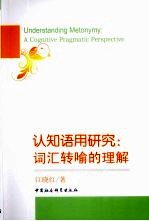

认知语用研究 词汇转喻的理解PDF电子书下载
- 电子书积分:10 积分如何计算积分?
- 作 者:江晓红著
- 出 版 社:北京:中国社会科学出版社
- 出版年份:2009
- ISBN:9787500477020
- 页数:201 页
Chapter One Introduction 1
1.1 The importance of metonymy in verbal communication 1
1.2 The target of research 3
1.3 Rationale of the research 8
1.4 Objectives of the study 10
1.5 Methodology for the research 13
1.6 Organization of the dissertation 14
Chapter Two Review of the Relevant Literature 15
2.1 Introduction 15
2.2 Structuralist views 16
2.3 The perspective of cognitive semantics 18
2.3.1 Reference-point phenomena 19
2.3.2 The idealized cognitive model 22
2.3.3 Meaning elaboration 25
2.4 The pragmatic approach 28
2.4.1 Previous pragmatic accounts of metonymy 28
2.4.2 A preliminary relevance-theoretic account of metonymy 31
2.5 The limitations in current accounts of metonymy 35
Chapter Three A Description of the Conceptual Framework 37
3.1 Introduction 37
3.2 The delimitation of metonymy for the present study 37
3.2.1 Linguistic realization of metonymy 37
3.2.2 The working definition of metonymy 42
3.2.3 Distinguishing metonymy from metaphor 45
3.3 Theoretical foundations 48
3.3.1 Relevance theory 49
3.3.2 Cognitive semantics 57
3.3.3 The complementarity of cognitive semantics and relevance theory 64
3.4 The characterization of the conceptual framework 67
3.4.1 Constraints involved in metonymy recognition 67
3.4.2 Comprehension heuristics employed in metonymy interpretation 68
3.4.3 Cognitive effects achieved in metonymy interpretation 69
Chapter Four Constraints on Metonymy Recognition 71
4.1 Introduction 71
4.2 Syntactic constraint:syntactic deviations 72
4.3 Semantic constraint:violations of selection restriction 77
4.4 Cognitive constraint:cognitive principles of relative salience 80
4.4.1 Human experience 81
4.4.2 Perceptual selectivity 83
4.4.3 Cultural preferences 84
4.5 Pragma-cognitive constraint:the constraining influence of context 87
4.5.1 Dynamic context 88
4.5.2 Mutual manifestness 95
4.6 Conclusion 99
Chapter Five Ad hoc Concept Construction of Metonymy 101
5.1 Introduction 101
5.2 Lexical pragmatics and ad hoc concept construction 102
5.3 The "transfers of meaning"issue 105
5.3.1 Reference transfer 106
5.3.2 Contextual variability of word meaning 108
5.4 An alternative solution to"transfers of meaning" 111
5.4.1 Cracking contiguity relations of metonymy 112
5.4.2 A refined relevance-guided comprehension heuristics 121
5.4.3 A cognitive pragmatic interpretation of metonymy:an application 126
5.5 Reference transfer and beyond 135
5.6 Conclusion 140
Chapter Six Cognitive Effects of Metonymy in Utterance Interpretation 142
6.1 Introduction 142
6.2 Economy considerations 143
6.3 Contextual implications 146
6.3.1 A trade-off between cognitive effort and cognitive effects 147
6.3.2 Highlighting of associative relations 150
6.4 Poetic effects 153
6.4.1 Strong and weak implicature 154
6.4.2 Speaking the unspeakable 156
6.4.3 Achieving interpersonal effects 162
6.5 Conclusion 166
Chapter Seven Conclusion 168
7.1 Major findings 168
7.2 Implications 174
7.2.1 Philosophical implications:sense and reference 174
7.2.2 Linguistic implications:semantics-pragmatics distinction 177
7.2.3 Logical implications:ways of inference and utterance interpretation 180
7.3 Suggestions for further study 182
Bibliography 184
后记 199
Lists of Figures and Tables 20
Figure 2-1 Reference-point phenomena 20
Figure 2-2 Metonymy expansion and reduction 27
Figure 2-3 Descriptive and interpretive dimensions of language use 32
Figure 3-1 Continuum view of metaphor and metonymy 48
Figure 3-2 An integrated account of metonymy 70
Figure 5-1 Narrowing 103
Figure 5-2 Broadening 104
Figure 5-3 Reference transfer 108
Figure 5-4 A refined relevance-theoretic comprehension heuristics 123
Figure 5-5 Types of metonymy 135
Figure 5-6 The continuum of"strength of contact" 136
Figure 5-7 Types of partonomy 137
Table 2-1 A general procedure for the comprehension of metonymy 34
Table 5-1 The comprehension heuristic steps involved in metonymy interpretation 129
- 《红色旅游的社会效应研究》吴春焕著 2019
- 《汉语词汇知识与习得研究》邢红兵主编 2019
- 《生物质甘油共气化制氢基础研究》赵丽霞 2019
- 《东北民歌文化研究及艺术探析》(中国)杨清波 2019
- 《联吡啶基钌光敏染料的结构与性能的理论研究》李明霞 2019
- 《异质性条件下技术创新最优市场结构研究 以中国高技术产业为例》千慧雄 2019
- 《法语词汇认知联想记忆法》刘莲编著 2020
- 《《国语》和《战国策》词汇比较研究》陈长书著 2017
- 《中国制造业绿色供应链发展研究报告》中国电子信息产业发展研究院 2019
- 《行政保留研究》门中敬著 2019
- 《急诊影像诊断学》程晓红责任编辑;(中国)许乙凯 2019
- 《储望华钢琴作品演奏解析》陈国红著 2019
- 《明清白话短篇小说的文学地理研究 上》杨宗红著 2019
- 《艺术家形象的塑造 关于工匠如何成为接受神圣灵感的艺术家的探讨》武红著 2017
- 《我的便携式生活》闫红著 2019
- 《科学建构 从几何模型到物理世界》(中国)江晓原 2019
- 《有机食品消费》魏胜,霍红著 2019
- 《计算机专业英语》邱晓红,吴沧海主编 2019
- 《蔬菜重金属控制原理与方法》徐卫红著 2019
- 《儿童行为心理学》江晓兴著 2018
- 《红色旅游的社会效应研究》吴春焕著 2019
- 《中国当代乡土小说文库 本乡本土》(中国)刘玉堂 2019
- 《社会学与人类生活 社会问题解析 第11版》(美)James M. Henslin(詹姆斯·M. 汉斯林) 2019
- 《异质性条件下技术创新最优市场结构研究 以中国高技术产业为例》千慧雄 2019
- 《中国铁路人 第三届现实主义网络文学征文大赛一等奖》恒传录著 2019
- 《莼江曲谱 2 中国昆曲博物馆藏稀见昆剧手抄曲谱汇编之一》郭腊梅主编;孙伊婷副主编;孙文明,孙伊婷编委;中国昆曲博物馆编 2018
- 《中国制造业绿色供应链发展研究报告》中国电子信息产业发展研究院 2019
- 《中国陈设艺术史》赵囡囡著 2019
- 《指向核心素养 北京十一学校名师教学设计 英语 七年级 上 配人教版》周志英总主编 2019
- 《《走近科学》精选丛书 中国UFO悬案调查》郭之文 2019
